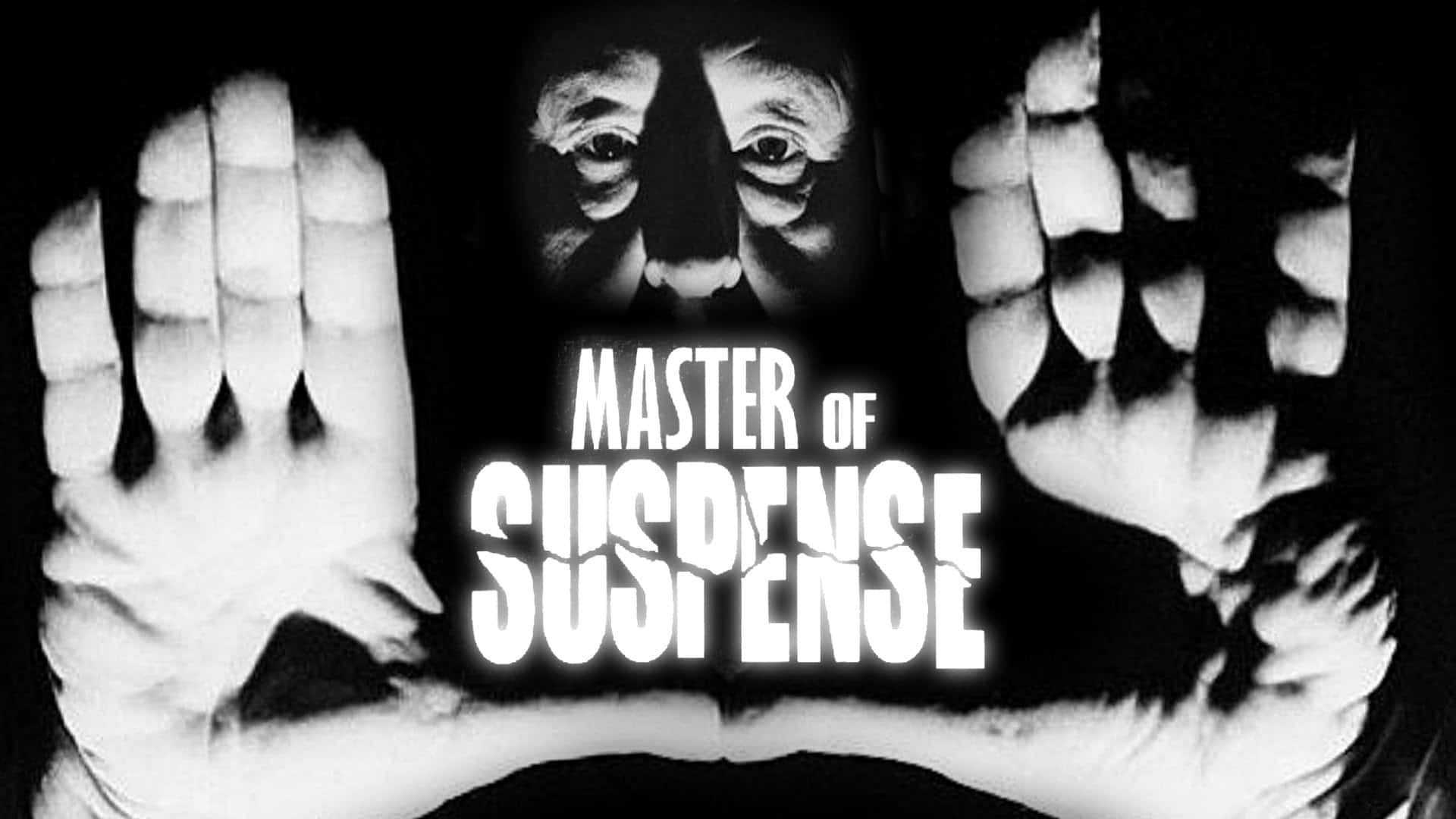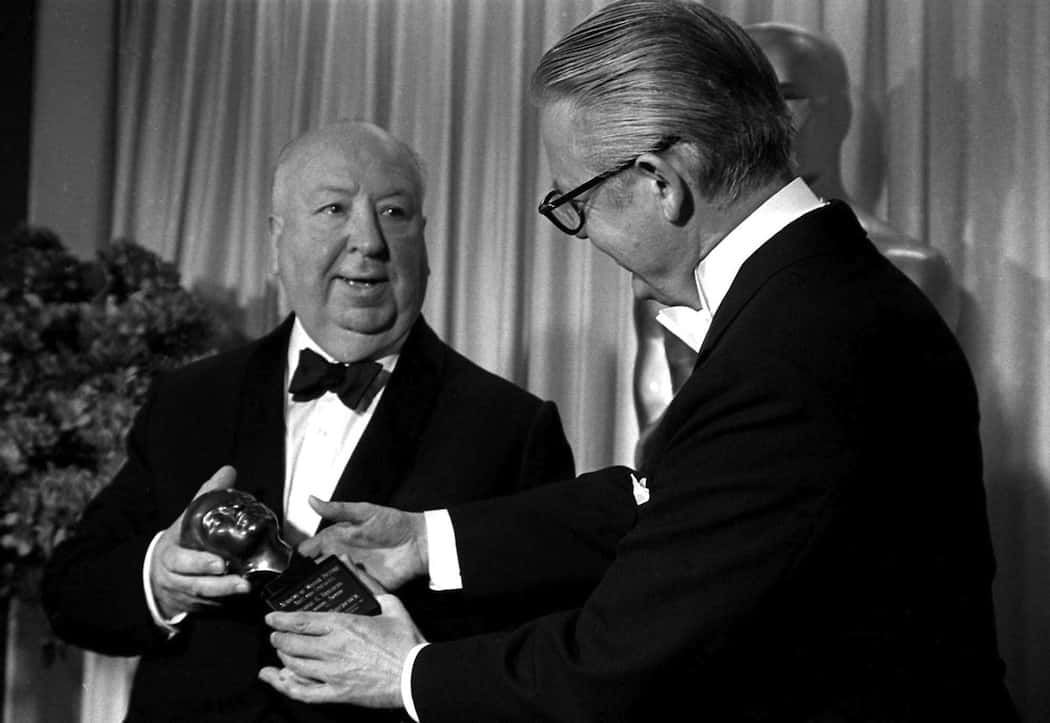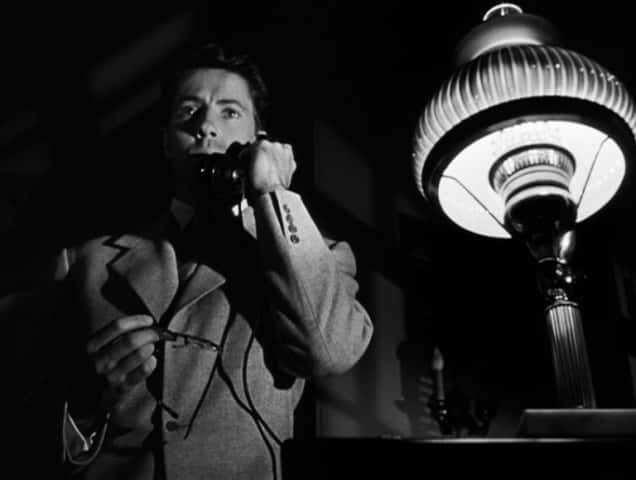“If it's a good movie, the sound could go off and the audience would still have a perfectly clear idea of what was going on.” —Alfred Hitchcock
Alfred Hitchcock was an English director and producer whose films were among the most influential in the history of film. He helped shape the thriller genre and over the course of 60 years, he directed 53 films. Below are 42 facts about his famous films.
Alfred Hitchcock Movies Facts
42. There He Is!
By the time he died, Alfred Hitchcock was as well-known as most actors. He gave numerous interviews throughout his career and he had cameo roles in 39 of his movies. He appeared in the background as a pedestrian, a bus or train passenger, and even in ‘before and after’ photos for a weight-loss product ad in a newspaper. As host of Alfred Hitchcock Presents between 1955 and 1965, he further increased his profile.
41. A Talking Film
1929’s Blackmail was Alfred Hitchcock’s first thriller and was one of the most successful British films of the year. It was also the first British film to have synchronized sound. The film began as a silent film and then was changed to sound during filming. Both a silent version and the version with sound were released in theatres and the silent version can be found in the British Film Institute collection.
 cracked rear viewer - WordPress
cracked rear viewer - WordPress
40. Blondes Didn’t Have Fun
Alfred Hitchcock often cast blonde actresses in his movies. According to The Guardian, his reason was that “Blondes make the best victims. They're like virgin snow that shows up the bloody footprints."
39. Not for Children
Psycho was released in 1960 but didn’t actually receive its “R” rating until 1984. When the MPAA system for rating movies was created in 1968, the film was given an “M” rating meaning suitable for mature audiences. In 1984, the film was resubmitted and was lowered to an “R” rating, meaning that children under 17 had to be accompanied by a parent.
38. Lost
One of Hitchcock’s early directing efforts, a film called The Mountain Eagle, tops the British Film Institute’s list of most desired lost films. All prints of the film disappeared, and the only remnants are some production photos and a lobby card that was discovered at a flea market. Hitchcock, on the other hand, was reportedly quite pleased that the movie disappeared, and was said to have called it a “very bad movie.”
37. Valued Collaborator
Alfred Hitchcock married his wife Alma Reville in 1926 and worked closely with her early in his career. She was a writer, script supervisor, editor and assistant director on several of his early films and he was known to ask her opinion after each take. As his career progressed, she was less involved with the shooting but continued to consult with him on key decisions regarding scripts, casting, and editing. She even convinced him to use the famous music from the shower scene in Psycho.
36. Part of the Process
Hitchcock was a notorious practical joker, and in some cases, his pranks became part of the creative process for his films. While filming The 39 Steps, he handcuffed the leads together and claimed to have lost the key. They stayed chained together for over an hour before he miraculously found the key again. At one point he claimed to be interested in “the drama of being handcuffed” as a major theme in the film and that the ‘ordeal’ was intended to help the stars develop chemistry.
35. Cinematic Bathrooms
Before Hitchcock, showing bathrooms in movies just wasn’t done and was considered to be offensive. Hitchcock apparently thought this taboo was silly and Psycho became the first American movie to show a toilet on screen. Thanks to Hitchcock, movie bathrooms have become a common horror/thriller trope, and a symbol of terror.
34. Six-Week Set Up
The set of Rear Window was far from an ordinary set. Hitchcock had the apartment complex in the movie constructed for the film, and it was the largest indoor set ever built at Paramount Studios. The complex took six weeks to set up and had a drainage system for the rain scene, and a special wiring mechanism to achieve the complex lighting for both the interior and the exterior.

History's most fascinating stories and darkest secrets, delivered to your inbox daily.
33. Visual Medium
Hitchcock got his start in silent film, and he brought his unique understanding of its visual nature to his films. He always believed that dialogue and sound should be secondary to the visual and just as he desired, it’s the images from the films that are most remembered.
32. Coining a Term
Hitchcock’s thrillers earned him the title “Master of Suspense,” and the term “Hitchcockian” is an adjective used to describe suspense thrillers that mimic his techniques.
 YouTube
YouTube
31. Battling the Censors
When Hitchcock started making movies in Hollywood, he was often frustrated with the strict guidelines that regulated movie content and would find crafty ways of getting around the rules. With Psycho, he sent the censors highly graphic scenes of violence and nudity to keep them from cutting the subtler scenes that were important to him. When asked to reshoot the sexually suggestive opening, he pretended not to understand and asked them to personally deliver instructions. When the censors didn’t show, he was able to keep the scene as is.
30. Never a Winner
Hitchcock received 5 Academy Awards nominations for Best Director for his movies, but he never won the award. In 1968, the Academy decided to honor him with the Irving G. Thalberg Memorial Award for his lifetime of achievement, for which he gave the shortest acceptance speech in Oscars history saying “Thank you...very much indeed.”
29. Didn’t Want to Tell Him
Jimmy Stewart collaborated with Alfred Hitchcock on four different films, but the director blamed Stewart for the initially poor reception of Vertigo. When it came time to film North by Northwest, Hitchcock wanted to use a different actor but didn’t want to tell Stewart, so he delayed filming until Stewart was no longer available and cast Cary Grant instead.
 cinemaemcena.cartacapital.com.br
cinemaemcena.cartacapital.com.br
28. Disrespect
In the film North by Northwest, Hitchcock wanted to have Cary Grant’s character hide from the bad guys in Lincoln’s nose on Mount Rushmore. The National Park Service refused permission, stating that was disrespectful to the monument. As a result, Hitchcock was forced to cut the scene.
27. Not Much for Debuts
Aspiring actors need not audition for a Hitchcock movie. He apparently preferred to work with already established actors who were known to audiences so that he could focus on the plot and not the actors.
26. On Second Thought…
When Vertigo released in 1958, it was largely panned by the critics, but that’s far from how it’s regarded today. Contemporary critics see the film in a completely different light and according to a 2012 Sight and Sound critics poll, it is an even greater film than Citizen Kane and is the best film ever made.
25. Hidden Camera
The United Nations Building in New York City had a strict policy against allowing movies to shoot on its grounds, and it was off-limits to Hitchcock in North by Northwest. To compensate, he had the studio build a model of the lobby for the interior scenes and set up hidden cameras across the street for the exterior scenes. No extras were used for the shots and the people seen in the in those scenes were real people who walked into the shot. Eagle-eyed viewers might even notice one passerby doing a double take when Cary Grant walked past him.
24. Keeping it a Secret.
Alfred Hitchcock was so intent on keeping the twist ending of Psycho a secret that he not only bought the rights to the novel but allegedly had his secretary buy up as many copies of the book as possible to prevent spoilers. He even kept the press out of screenings and took out ads in the paper begging audiences not to give away the ending.
23. Sound Effects Only
For the movie The Birds, Hitchcock hired Psycho composer Bernard Herrmann, but not to compose music. He wanted Hermann to concentrate on the noises that the birds would make before attacking to make the film more frightening.
22. Five Lost Hitchcocks
While not exactly lost, 5 of Hitchcock’s films were unavailable to the public for 30 years. Hitchcock bought back the rights to The Man Who Knew Too Much, Rope, Vertigo, Rear Window, and The Trouble with Harry after their first run, meaning that they could only be screened again if he were paid a royalty, He willed the rights to his daughter Patricia after his death, and she held onto them for another 5 years before releasing the rights. The films were dubbed the “Five Lost Hitchcocks” by his fans.

21. Real-Time (Sort Of)
The movie Rope is 80 minutes long and is supposed to take place in real time, but the actual time frame for the movie is a little over 100 minutes. The film was shot in ten takes that ranged from 4.5 minutes to 10 minutes, and with just subtle 10 edits that were engineered to make it look like one continuous shot.
20. Milestones
Hitchcock’s 1927 film The Lodger marked a number of firsts for the director. It was the first of his films in which he made a cameo, Hitchcock considered it to be his first true suspense film, and it was his first commercial hit.
19. I’m Innocent!
The theme of an innocent man accused of a crime recurred in more than half a dozen of Hitchcock’s films. According to Hitchcock, “the theme of the innocent man being accused…provides the audience with the greatest sense of danger”.
18. Largely True
Alfred Hitchcock’s narration in the movie The Wrong Man is the only time his voice is heard on screen. It is also the first of his movies to be made that was based on real events, though some details were deliberately left out to increase the tension.
17. Prolonging the Thrill
Hitchcock was always aiming to stretch out the suspense of a scene for as long as possible to keep the audience hooked. To achieve this, he would switch between camera shots and make use of shadows which helped create tension.
16. MacGuffin
A MacGuffin is a literary device used to drive the plot and hook readers in which there is a goal or an object that the main character will go to almost any length to pursue, but no explanation is offered as to why. Hitchcock was extremely fond of using this in his films and popularized the term and the method in Number Seventeen and The 39 Steps.

15. Always Bad Cop
As a child, Hitchcock’s father had him locked up in a cell for several minutes at a police station, warning him that “This is what happens to people who do bad things”. As a result, Hitchcock developed a lifelong fear of police, which he transferred to his movies. Cops are definitely not the heroes of his films and are usually portrayed as bad guys.
14. Fierce Moms
A motif that Hitchcock used frequently in his movies is that of the strong or domineering mother who is intrusive and controlling to the point of driving their sons crazy. These tormenting mothers can be seen in almost all of his movies, but why he was fascinated by this type of character is unknown. Hitchcock was known to have difficult relationships with his female stars, and there has been speculation that he may have had a rocky relationship with his own mother.
13. Preserved for All Time
The United States National Film Preservation Board was founded in 1988 and selects films to be preserved in the National Film Registry in the Library of Congress. The films selected are either culturally, historically or aesthetically significant and to date, seven of Hitchcock’s films have been included in the registry. The first film to be included was Vertigo in 1989, and most recently, Notorious in 2006.
12. Unique Use of Sound
In the movie Rear Window, Hitchcock used a unique technique to make the setting more authentic. All of the sound in the film is diegetic, which means that outside of the orchestrations, all of the sounds were natural noises from the location. Hitchcock was the first to use this method, which didn’t become widely used for twenty more years.
11. Recurring Characters
Basil Radford and Naunton Wayne’s characters Charters and Caldicott first appeared in The Lady Vanishes but ended up being so popular, that they showed up in other films and two BBC radio serials.
10. Director’s Revenge
Producer David O. Selznick and Alfred Hitchcock worked together on a number of films but had what was described as a ‘turbulent’ relationship. It’s been said that Hitchcock’s animosity for Selznick influenced the villain portrayed by Raymond Burr in Rear Window. The character’s look was based on Selznick, and Hitchcock would reportedly show Burr how to imitate Selznick’s mannerisms.
9. A Look Like No Other
When 3D movies became popular in the 1950s, Hitchcock was forced by Warner Brothers to shoot Dial M for Murder with 3D cameras. As a means of making the film look interesting, he had a pit added to the set floor in order to allow the camera to move at lower angles and capture objects in the front. Ironically, by the time the film was ready for release, the fad was just about over, and the film was mostly shown in 2D. It was the only one of his films to ever be shot this way.
8. Disney Killed It
Even Alfred Hitchcock wasn’t always able to get projects off the ground, and one such project was the unmade film The Blind Man, which Hitchcock planned for Jimmy Stewart to star in. Disneyland was supposed to be the setting of one of the film’s major scenes, but Walt Disney, having seen Psycho and been disgusted by it, refused to allow him to film there and effectively killed the project.
7. Vertigo Effect
For the movie Vertigo, Alfred Hitchcock invented a camera shot called the dolly zoom, which is sometimes called the Hitchcock zoom or the Vertigo effect. In the shot, the camera lens zooms in while the camera moves away, or vice versa. If the camera moves closer, the background becomes dominant, and if it moves farther away, the emphasis switches to the foreground subject (such as a person). The shot was originally used to show the audience what the main character was experiencing every time his fear of heights acted up.
6. Wardrobe Psychology
The mental state of Margot, the female lead in Dial M for Murder is reflected in her choice of clothing. At the beginning of the film, she wears bright colors which signifies happiness. As the film progresses, her clothing becomes darker, suggesting her darkening mood.

5. Studio Preferred
According to Hitchcock’s daughter Patricia, Hitchcock hated filming on location. He felt that getting the right light was too difficult, and the noise required the film to be redubbed. His preference was to film in a studio where he had complete control.
4. Surreal Sequence
The film Spellbound features a dream sequence created by the surrealist painter Salvador Dali. Hitchcock was unhappy with the way that dream sequences in movies had been done to date, and he chose Dali for the “architectural sharpness of his work” but also acknowledged that Dali had some odd ideas. About 20 minutes of footage was created, and it was edited down to fit the film.
3. Missing “The End”
The Birds was the only one of Hitchcock’s films not to have “the end” at the end of the movie. Hitchcock purposely left it out of the film, wanting to create an ambiguous ending that would leave the audience with a never-ending sense of fear.
2. Neither Works
There were two different endings for Strangers on a Train. One was the ending that was shown by Hitchcock to preview audiences, and the other was the one shown in theatres. The preview version ended with Anne getting a phone call from Guy letting her know that he’s all right but Warner Brothers thought the preview ending was too abrupt and forced Hitchcock to add an extra scene. Neither ending satisfied Hitchcock, who wanted to end the film before the final scene in the preview.
1. Returning Home
Hitchcock’s penultimate film Frenzy was the first movie to be shot in London since 1950’s Stage Fright. It is the only Hitchcock film to ever be given an X rating in the UK and was his most commercially successful film since Psycho.
Sources: 1, 2, 3, 4, 5, 6, 7, 8, 9, 10, 11, 12, 13, 14, 15, 16, 17, 18, 19, 20, 21, 22, 23, 24, 25, 26, 27, 28, 29, 30, 31, 32, 33, 34, 35














































